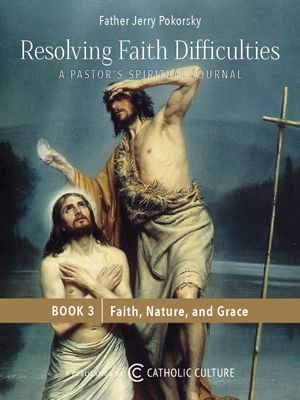beyond equality
By ( articles ) | Oct 07, 2003
In the Pope's letter "On the Dignity and Vocation of Women" he makes a small but vitally important point. You can find it in the section (#29 entitled "the Dignity of Women and the Order of Love."
He states that "the dignity of women is measured by the order of love" and he defines the order as follows: "the Bridegroom is the one who loves. The Bride is loved: it is she who receives love, in order to love in return." (Emphasis in the original.)
To me, this insight is immediately (if you haven't been indoctrinated by feminists, that is) recognizable as the answer to the age-old question: What IS the difference between men and women? The Pope puts his finger on it: men love, women receive love in order to love in return.
That being so, and I deeply believe it IS so, a whole host of issues can be resolved. Why ought there not to be altar girls or for that matter any women in the sanctuary during the Liturgy? Because what's going on there is a ritual of love, of giving love -- according to the Pope, in the order of love, a masculine attribute.
Those who receive love (don't leave out the next clause -- "in order to love in return") frustrate that order when they insist on an equal part in the proceedings. You could say they interpret a dance as a bureaucratic shuffle, with all the resulting loss of poetry, beauty, and meaning.
"Equality isn't the deepest thing," C. S. Lewis says (in just this context: Ransom is explaining Jane's unwillingness to give of herself in marriage in That Hideous Strength). Even men are "Bride" to the overpowering masculinity of God. Another clue as to why the sanctuary shouldn't be cluttered with a bunch of people, male or female, mistakenly thinking they are more actively participating in their faith by being there. However, men are more fitted than women by their masculinity to assist at Mass. And that really is what it comes down to.
The congregation isn't excluded from anything by being on their side of the altar rail (hmm, an ontological argument for altar rails?), certainly not any defining role in faith. On the contrary, the congregation fulfills the indispensible role of receiving the love that God so loved, He gave up His only begotten Son for.
In order to love in return! There's a whole world out there in need of that motherly love, and only the lay members of the Church, Bride to Christ's Bridegroom, can give it in this particular way, according to the order of love.
All comments are moderated. To lighten our editing burden, only current donors are allowed to Sound Off. If you are a current donor, log in to see the comment form; otherwise please support our work, and Sound Off!







